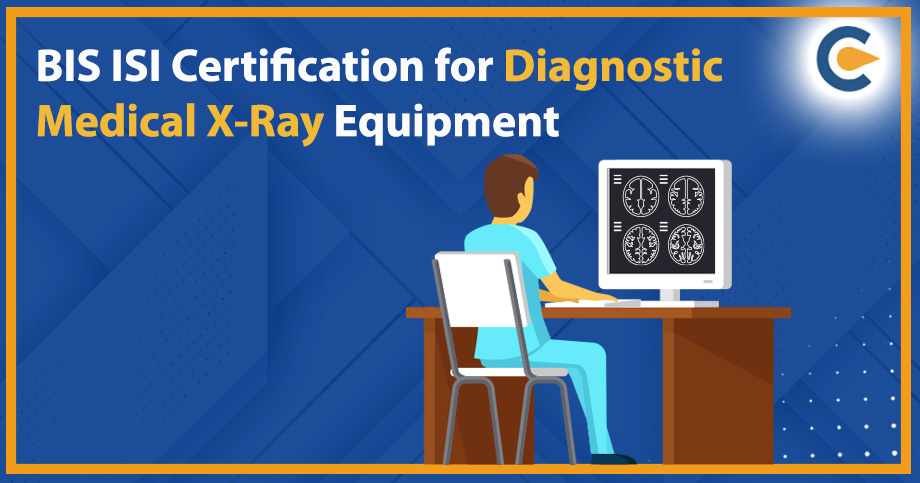Diagnostic Medical X-ray equipment is primarily used to take pictures of areas inside the body. It focuses a small amount of radiation on the particular area of the body to examine. The x-rays pass through the body & create a picture on a computer display or on a thin film. All the Manufacturers of Diagnostic Medical X-ray equipment in India are required to comply with the Mandatory Product Certification under IS 7620 (Part-1) as per BIS. All the Manufacturers or Importers of Diagnostic Medical X-ray equipment are applicable to sell their products in the Indian Market only after obtaining BIS ISI Certification for Diagnostic Medical X-ray equipment issued by the Bureau of Indian Standards (BIS). ISI Mark[1] on the product ensures the product’s quality along with the consumer’s safety. So, the manufacturers of x-ray equipment must have the BIS ISI Certification for Diagnostic Medical X-ray equipment after proper testing under BIS.
Growth of the Medical Care Sector in India
The Medical Care Sector is trusted to observe development in future, inferable from the headways in innovation (the discovery Diagnostic Medical X-ray equipment has advanced to turn out to be more strong, protected & simple to use). Moreover, in a non-industrial country like India, expanding earnings, simpler admittance to top-class medical care offices and more prominent familiarity with individual well-being & cleanliness are the components supporting the development of the Medical Services Industry.
Also, the more important infiltration of Health Care coverage supported the ascent in medical care consumption. Alongside that, with the expanding interest in reasonable & quality medical services, the entrance of health care coverage is ready to fill intensely later on. The expanding medical services costs & weight of new infections, combined with low Government financing, are helping to increase the interest in healthcare coverage inclusion.
The Indian Government intends to expand public medical care use by 2.5% of India’s GDP by 2025 and this move would support the other rising economies to build their uses.
Benefits of Obtaining BIS ISI Certification for Diagnostic Medical X-ray Equipment
The following are the benefits of getting BIS ISI Certification for Diagnostic Medical X-ray Equipment:
- ISI-certified products give a new push to quality control, reliability, standardisation, and safety of the customers’ product;
- ISI-certified products guarantees both better performance & longer shelf-life;
- In case the customer is not satisfied with the quality of the particular product with the ISI Mark, then the Company will give the customer a new product in return to it;
- This Certification lessens the losses of the business and product rejection;
- An ISI-certified product verifies the quality of its products.
General Requirements for BIS ISI Certification for Diagnostic Medical X-ray Equipment
The following are the general requirements for BIS ISI Certification for Diagnostic Medical X-ray Equipment:
- Mechanical & Physical Requirements:
- X-ray equipment shall be so formed & assembled that it shall have the rigidity & strength to resist the abuses to which it is liable to be subjected without increasing its fire hazard due to total or partial collapse with a resulting reduction of loosening, spacing, or displacement of parts/other series defects.
- Sheet metal employed as an enclosure for x-ray equipment should be such thickness or shall be so formed/reinforced that its strength & rigidity should not be less than that of a flat steel sheet having an average thickness of 0.6mm.
- The equipment’s electrical parts shall be so located/enclosed that suitable protection against accidental contact with uninsulated live-metal parts shall be provided.
- Equipment parts which move shall be arranged/protected against contact in such a manner that the operator is endangered.
- Equipment which is in use is placed on a table or on the floor and, when overturned, may present a hazard for the user or surroundings, shall have adequate stability.
- Equipment should be manufactured in a manner that its electrical insulation may not be affected badly by water condensing on cold surfaces or by water leaking from hoses, couplings, and receptacles.
- Protective sleaving shall only be used as supplementary insulation on insulated wires and shall be held in position by suitable means.
- Cords, fuses, receptacles, attachment plugs, lamp holders, circuit breakers, motor-operated components, etc., which are provided as parts of X-ray equipment, shall be chosen regarding their suitability for the specific application & shall conform to appropriate Indian Standards (IS). In case an Indian Standard is not available, then it will be as agreed to between the purchaser & the manufacturer.
- High-voltage equipment containing oil shall not be installed in a wooden cabinet.
- All high-voltage equipment parts, including the X-Ray tube, shall be enclosed within a metallic enclosure provided with a means for earthing, if within an enclosure of suitable insulating material.
- It shall not be possible to remove parts which make sure the requisite degree of protection against moisture without the help of tools.
- It shall not be possible to fix in a wrong position actuating parts which show the setting of switching or setting devices, the incorrect of which may be the cause of danger to the patient or user (for example, circuit breakers, power controls, or main switches) as well as actuating parts which have to be removed in use.
- The equipment shall have a device by means of which it may be separated on all poles from the mains.
- Protective casings and protection devices shall have enough mechanical strength. They shall not be removable without the aid of a tool unless their removal is vital for proper use. Thermal cut-outs with automatic resetting & overload protection devices shall not be used; they may cause danger by unintentionally switching on again.
- Radiation Protection: The X-ray equipment shall conform to all the relevant requirements prescribed under IS: 7061 for the protection of patients & personnel against ionising radiation.
- Temperature Rise: Materials employed in the construction of X-ray equipment shall not be affected badly by the temperature attained under any condition of normal operation & also under the condition of normal idling (12 hrs). The temperature rise of different parts & materials shall not exceed the prescribed values.
- Earthing:
- X-ray equipment shall have provision for earthing of all exposed metal parts.
- All parts of earthing conductor & terminal shall be corrosion-proof.
- The connection between the earthing conductor terminals/earthing contact & the parts to be connected to the earth conductor shall be of low resistance.
- Live Metal Parts:
- No part of the frame or enclosure of x-ray equipment shall be used as a current-carrying part except for the self-contained tube head, which is earthed.
- Friction between surfaces shall not be acceptable as a means to prevent the turning of live-metal parts, but an appropriate lock washer properly applied may be acceptable for this purpose.
- Uninsulated live-metal parts shall be so secured to the base/mounting surface that they will be prevented from shifting/turning in position if such motion may result in a reduction of spacing below the minimum required.
- Wiring and its Terminals: The wiring connection between parts of X-ray equipment shall be protected/enclosed, except that a suitable length of flexible cord or cable may be employed for external wiring or for interconnection between various components of the equipment of flexibility is vital.
Various Tests Required for BIS ISI Certification for Diagnostic Medical X-ray Equipment
Tests Required for BIS ISI Certification for Diagnostic Medical X-ray equipment are broadly categorised into two different categories mentioned below:
- Type Tests: The following shall include the type tests (for safety requirements):
- Test for accuracy of indication for the x-ray control;
- Test for stabilisation with internal temperature changes for the X-Ray control;
- Recycling time test for the x-ray control;
- Milliampere (mA) stabilisation test for the x-ray control;
- Test for interlocks;
- Grid clear-up (for potter bucky & x-ray grid);
- Grid pattern test (for potter bucky & x-ray grid);
- Stator voltage & current test;
- Installation test;
- Test on tube stand;
- Magnification test for body section devices;
- Exposure angle & location of objective plane test for body section devices;
- Test on x-ray table;
- Section thickness test
- Routine Tests: The following shall constitute the routine tests:
- Visual examination & inspection;
- Test for interlocks;
- Test on x-ray table;
- Time test for x-ray con troll;
- Current test and stator test;
- Installation test.
Documents Required for BIS ISI Certification for Diagnostic Medical X-ray Equipment
Following is the list of basic documents required for BIS ISI Certification for Diagnostic Medical X-Ray Equipment:
- Address proof of the manufacturing unit or premise;
- A copy of the Trademark Registration Certificate;
- Identity proof of the applicant or manufacturer;
- A copy of the Certificate of Registration;
- Details of equipment used for testing;
- Proof of Indian Residency;
- Particulars regarding the raw material being used;
- Factory layout plan;
- Product drawing;
- Latest utility bills like gas bills, water bills, electricity bills;
- Packaging details like quantity, product size, storage facility etc.;
- A certified copy of the test report by a BIS-authorised lab;
- Flow chart of the manufacturing process;
- Copy of the Company’s bank statement.
Procedure for Obtaining BIS ISI Certification for Diagnostic Medical X-ray Equipment
Following is the step-by-step procedure for obtaining BIS ISI Certification for Diagnostic Medical X-ray Equipment:
- Select Product Code: The first is to select the product quality that follows all the guidelines set by the BIS. The applicant or manufacturer must identify & choose an ISI standard product code for their product.
- Filing Application. After selecting the product code, the next step is filing the application. For that, the applicant needs to fill out the application form correctly. Further, the applicant must pay the audit fee & registration fee for further inspection.
- Inspection of the Factory Premise: Once the applicant file the application, then the BIS Office & the inspection team will visit the factory premise or the manufacturing unit of the applicant & examine the quality control & manufacturing process. The BIS Officer will collect some products as samples & send them for testing in a BIS-authorised lab.
- Submit Product Sample Report: It is important to submit the product sample report from the BIS-certified labs & submit it to BIS.
- Grant of BIS ISI Certification: Once the application & inspection process is completed, then the Bureau of Indian Standards issues a Certificate.
Reasons for the Rejection of the BIS ISI Application
Following are some conditions which, if not complied with, then BIS will reject the Application of BIS ISI Certification for Diagnostic Medical X-ray Equipment:
- If the samples of the product are not submitted for testing after submitting the BIS ISI Application;
- If the firm hasn’t submitted the right documents;
- If there are lack of facilities for testing by the manufacturer;
- In case there is a failure on the manufacturer’s side to provide assistance to visiting officials during the factory visit;
- The firm or the applicant is involved in illegal or unethical practices.
Conclusion
As mandated by law, it is important to get a BIS ISI Certification for Diagnostic Medical X-ray Equipment as it not only ensures certain quality & safety standards but is also required if a Manufacturer wants to sell, import, or export Diagnostic Medical X-ray Equipment in India.
Read Our Article: CDSCO Medical Device Registration for X-Ray Machine













